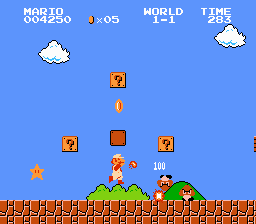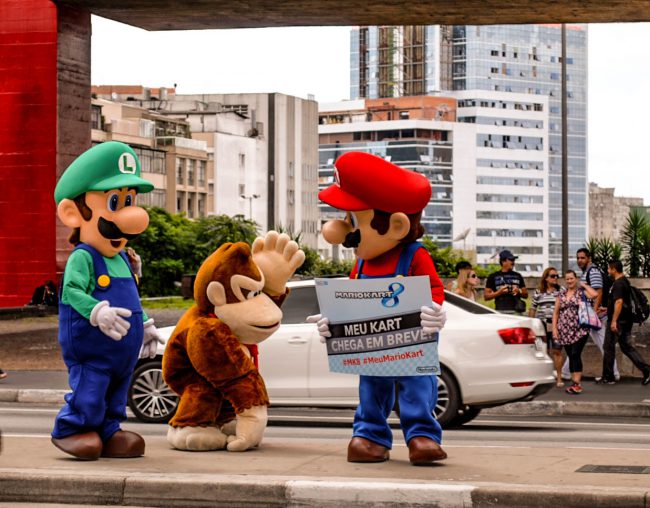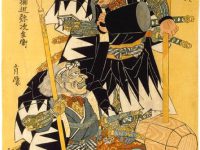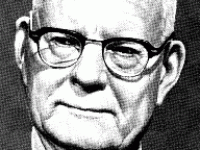
Super Mario Bros.
On September 13, 1985, Nintendo‘s jump-’n’-run video game Super Mario Bros. was released and Princess Toadstool could finally be saved from Bowser and his evil forces by the hero of the Mushroom Kingdom, Super Mario!
Jump ‘n’ Run
Industrial designer Shigeru Miyamoto, who was hired by Nintendo in 1977, developed titles such as Donkey Kong (Arcade, 1981) and Mario Bros. (Arcade, 1983) with the later Game Boy inventor Gunpei Yokoi [6]. The success of these games enabled Nintendo to enter the home console market in 1983 with the Famicom. Later, the company introduced the console as Nintendo Entertainment System (NES) into the western markets as well. With Donkey Kong, Nintendo had created a new kind of game, which is catalogued under the subsequently established genre name “Jump ‘n’ Run“. In the following years, Nintendo increasingly lost its genre leadership to other manufacturers. Miyamoto, who regarded the genre as Nintendo’s own creation, therefore tried to rejoin the genre with a new, ambitious project.
Mario’s Jumps
Developers Shigeru Miyamoto (who developed ‘The Legend of Zelda‘ simultaneously) and Takashi Tezuka were able to make Mario’s jumping abilities such as jumping as high or far as the player decides very precise, which is now seen as the reason for the game’s great success. In December 1984, under Miyamoto’s direction, the SRD programmers developed the first prototype of the later Super Mario Bros., in which a character twice the size as in Mario Bros. jumped around. This prototype used a rectangle measuring 16 × 32 pixels as a placeholder for the game character. No specific game character was assigned to the project at that time. It was only after Tezuka learned of the success of Mario Bros.’s Famicom port that he suggested integrating Mario as the protagonist in the new project. After the team had decided to integrate both horizontal and vertical level progress into the game, the sky and underwater sections were created.

Mario, Luigi, and Donkey Kong, by Photographer Felipe Veiga
Super Mario Bros
Super Mario Bros. became the second best selling video game in the world. Also a neat and from the start promising effect depict the mushrooms in the gameplay. Whenever Mario consumes these he would power up and grow much bigger. This idea was taken from Lewis Carroll’s ‘Alice in Wonderland‘, where Alice uses the mushrooms in her mysterious world to either shrink or grow.[5] Also included were childhood memories of Miyamoto, who as a child had explored mountain landscapes and caves.
Mario and Luigi
But coming back to the protagonist, have you ever wondered, where the the famous plumber got his name from? During the development of the game, Nintendo America faced heavy financial difficulties and their landlord came for a visit, claiming his money. His name happened to be Mario Seagale and to please him, the company named the protagonist after him. However Mario’s special look is to be attributed to Miyamoto, who declared that in 8-bit graphics a mustache would be easier to recognize as a mouth. Also the superhero wears an overall so that arm movements were easier to notice. But Mario was not the only “good guy” in the game. Presumably everyone who happened to have an older sibling knows one other character very well: Mario’s little brother Luigi. He was not as popular as Mario due to his character being described as very anxious and easily scared, he was also taller and skinnier than his older brother. Nevertheless he was an important part of the game and a reason for its success.
Level Design
The objective for the level design of Super Mario Bros. was that, ideally, the player should take about a minute to play through one of the 32 sections of the game. The resulting length of the guide was about 20 screens. Some of you might remember these days when bugs in games could not be fixed through a quick update of the app on your device. In Super Mario Bros. there were several bugs, also called ‘glitches‘, allowing the player to run through hazards or get through enemy attacks without being harmed. One bug in Mario Bros. has become very popular. It is called the ‘minus world‘, leading Mario into a random, infinite and unbeatable world. Even though players found out a way to solve the issue, it has definitely caused thousands of players some moments of despair.
Despite the Bugs
Despite the bugs, Super Mario Bros. was able to critically influence the video game industry and could enormously boost the success and reputation of Nintendo. The game was sold more than 40 million times and the great outcome has caused something like a cultural mass movement in the field of gaming. The popularity of jump and run games increased and the game characters – especially Mario – turned into pop-icons.
Merchandising
In 1993 a movie called Super Mario Bros. came to the cinemas. The directors were Annabel Jankel and Rocky Morton, the leading roles were Bob Hoskins (Mario), John Leguizamo (Luigi) and Dennis Hopper (Bowser). Super Mario Bros. is considered to be the first film about a video game and was often rewritten during its three-year development phase. Despite its title, it is less a film adaptation of the game than an adaptation of the entire Super Mario universe developed to date. The movie Super Mario Bros. received negative reviews. In the USA, he only made just under half of his production budget of around 40 million US dollars, which represents a commercial failure.[7]
Super Mario Bros. – Lecture 4 – CS50’s Introduction to Game Development 2018 [8]
References and Further Reading:
- [1] Super Mario Bros. Wiki
- [2] Super Mario Bros. at Wikidata
- [3] Happy Birthday Pac Man, SciHi Blog
- [4] Have you played Atari today?, SciHi Blog
- [5] Lewis Carroll – Mathematician and Creator of the Wonderland, SciHi Blog
- [6] The Triumph of the Game Boy, SciHi Blog
- [7] Super Mario Bros. in der Internet Movie Database
- [8] Colton Odgen, David J. Malan, Super Mario Bros. – Lecture 4 – CS50’s Introduction to Game Development 2018, Harvard University, CS50 @ youtube
- [9] Timeline of Mario Platform Games, via Wikidata and DBpedia





